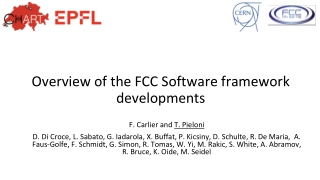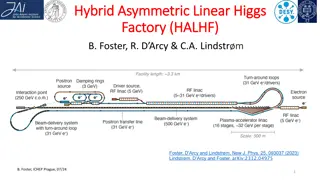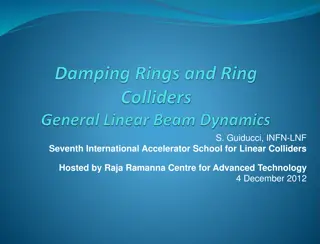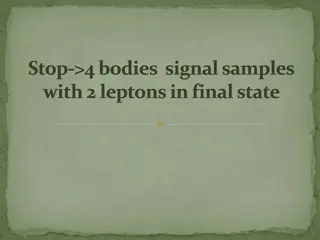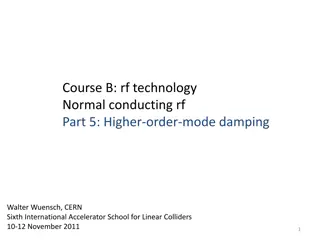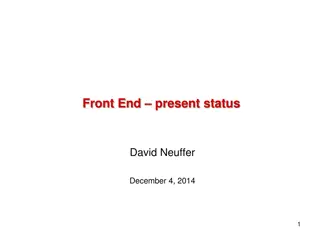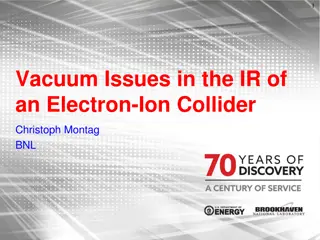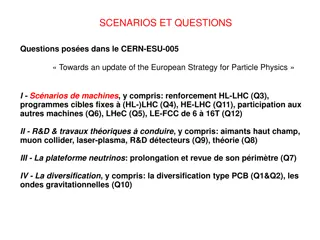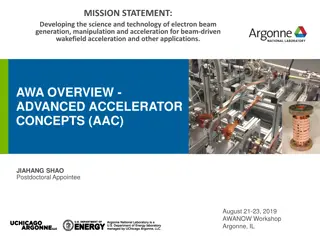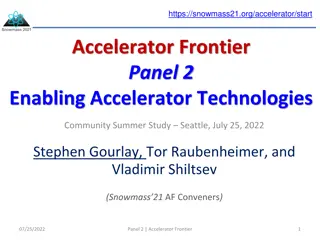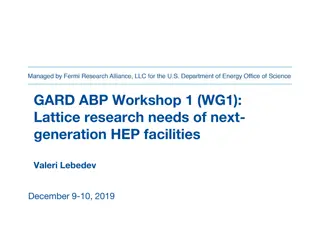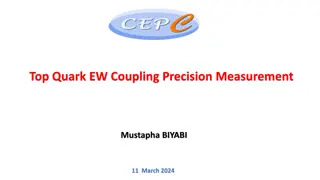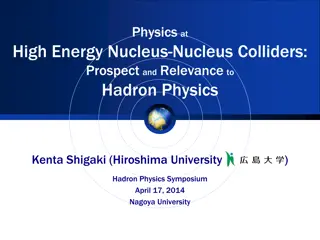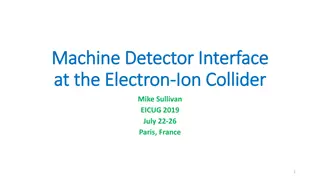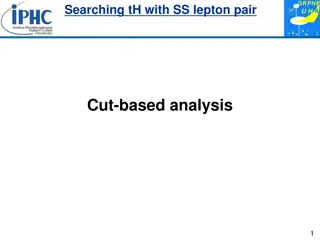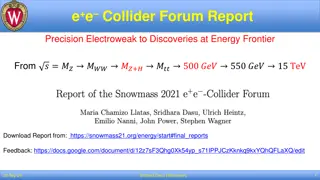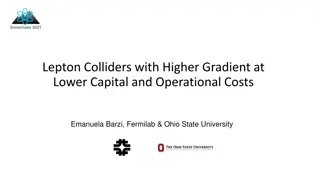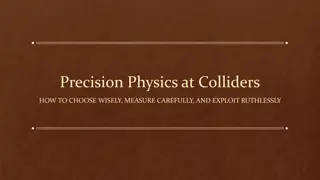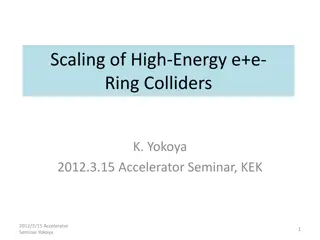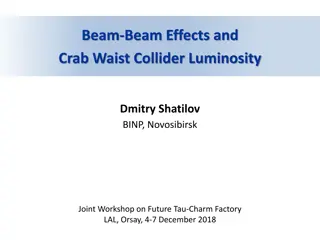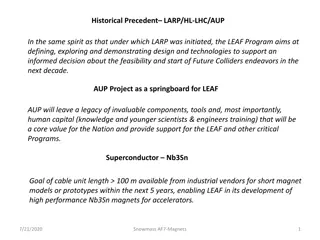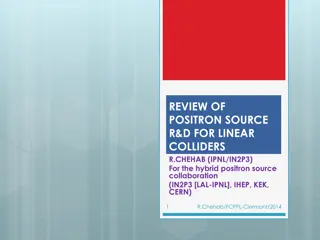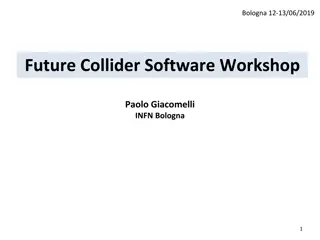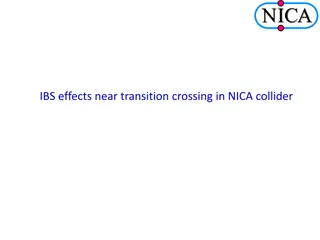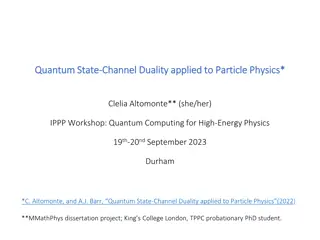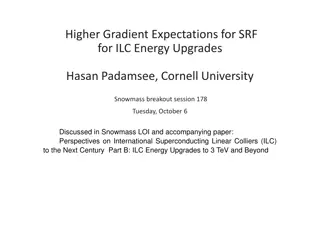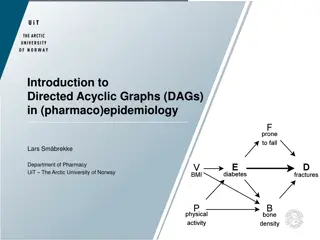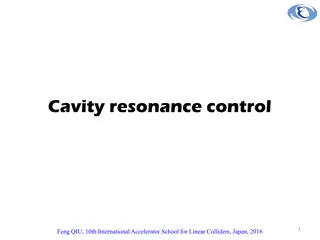Overview of the FCC Software framework developments
Overview provides information on the developments of the FCC Software Framework (SF) project, including modular software design and simulation capabilities for the Future Circular Lepton Collider (FCC-ee). It covers topics such as beam-beam interactions, lattice descriptions, beam lifetime studies,
1 views • 24 slides
High-Energy Recycling in E+ E- Colliders: Energy Recovery Linacs (ERLs) Advancements
High-energy recycling in E+ E- colliders involves the innovative concept of Energy Recovery Linacs (ERLs), pioneered by experts like Vladimir N. Litvinenko. These ERLs effectively recycle energy from collided beams, reducing energy consumption and increasing collider efficiency by maximizing luminos
1 views • 21 slides
New ILD Strategy: Consequences on ILD Tracking and Momentum Resolution
The ILD collaboration is adapting its strategy for potential circular colliders like FCC or CEPC, discussing challenges in tracking distortion correction, momentum resolution requirements, and handling various backgrounds. The focus is on optimizing the ILD design to meet the evolving collider lands
0 views • 11 slides
Innovative Hybrid Asymmetric Linear Higgs Factory (HALHF) Proposal
Cutting-edge proposal for the HALHF facility aiming to revolutionize particle acceleration technology by utilizing a hybrid asymmetric approach for electron-positron colliders. The design focuses on cost-efficiency and performance optimization, showcasing potential for significant advancements in hi
0 views • 18 slides
Accomplished Career in Nuclear Physics and Gamma-ray Spectroscopy
Experienced professional with a diverse background in nuclear physics and gamma-ray spectroscopy. Successfully held positions including Senior Gamma-ray Scientist, Professor, Associate Pro Vice Chancellor, and more. Achieved significant milestones such as securing research funding, supervising PhD s
1 views • 4 slides
Overview of Damping Rings in Linear Colliders
This content provides insights into the basics of damping rings in linear colliders, covering topics such as ring equations of motion, betatron motion, emittance, transverse coupling, dispersion, and momentum compaction factor. It delves into the equations of motion governing particle behavior in el
3 views • 34 slides
Exploring Stop Quark Decays in High-Energy Physics Experiment
In this study, we delve into the analysis of Stop quark decays in the final state with 2 leptons, focusing on the soft single lepton and dilepton channels. The CMS experiment at 8 TeV energy level explores 4-body decays with varied mass ranges and selection criteria, aiming at better exclusion limit
0 views • 16 slides
Managing Higher-order Modes in Normal Conducting RF Technology
The excitation of higher-order transverse modes due to misalignments between the beam and RF structures can lead to beam instability in linear colliders. This instability can be mitigated by selectively damping the transverse modes and/or detuning the dipole mode frequencies. Understanding the diffe
0 views • 34 slides
Current Status of Front End Systems in Particle Collider Research
David Neuffer presented the current status of front end systems for particle colliders on December 4, 2014. The presentation covered various aspects like baseline examples, beam characteristics, drift mechanisms, cooling methods, and simulation results. It provided insights into the operational mech
0 views • 15 slides
Advanced Beam Dynamics and Machine Protection in High-Energy Linacs
Overview of recent talks and discussions at LCWS 2014 in Belgrade, Serbia, focusing on machine protection, simulation codes, instrumentation, and system tests. Topics include beam-loss monitors, dark current measurements, simulation code developments, and beam dynamics studies in linacs. Key speaker
0 views • 12 slides
Challenges and Upgrades in Electron-Ion Collider Interaction Regions
The article discusses vacuum issues, design challenges, and experiences in the interaction regions of Electron-Ion Colliders. It explores the unique characteristics of the HERA collider, including beam currents, bunch spacing, and straight sections. Additionally, it covers the upgrades and improveme
0 views • 25 slides
Update of European Strategy for Particle Physics: Scenarios and Questions
Briefing book by CERN's Physics Preparatory Group outlines the landscape of particle physics field and proposes five scenarios for future major colliders in Europe, including HL-LHC, CLIC, FCC, LHeC, and LE-to-HE-FCC-h/e/A. The book emphasizes the need for technology decisions and investments to rea
0 views • 6 slides
Advancing Electron Beam Technology for Accelerator Applications
Focusing on electron beam generation, manipulation, and acceleration, this initiative aims to drive advancements in beam-driven wakefield acceleration and related fields. The program at AWA explores high-gradient acceleration for future colliders, collaborating on research and development projects w
0 views • 21 slides
Future of Accelerator Technologies: Enhancing Colliders and R&D Programs
The Accelerator Frontier Panel discusses the crucial components to enable future accelerators, emphasizing the need for a National Future Collider R&D Program, General Accelerator R&D, and adequate accelerator and test facilities. The message stresses the importance of an integrated future collider
0 views • 17 slides
Recommendations for Advancing Beam Physics and Accelerator Education
The exploration of new physics demands future accelerators beyond 1 TeV lepton colliders and 100 TeV hadron colliders, requiring luminosity in a specific range. Various challenges, including reaching quantum limits, face conventional RF-based beams. The pursuit of disruptive acceleration technologie
0 views • 7 slides
Beam-beam Effects in Future Hadron Colliders Workshop
Explore the beam-beam effects in the SPPC and future hadron colliders, presented at the International Workshop on High Energy Circular Electron-Positron Colliders. The workshop covers weak-strong beam-beam simulations, collision models, and parameter values for the SPPC. Detailed discussions on the
0 views • 32 slides
Lattice Research Needs for Next-Generation HEP Facilities
Lattice research is vital for determining the characteristics of accelerators, colliders, and storage rings. High beam brightness is crucial for achieving goals like luminosity and beam loss reduction. The main barriers to higher beam brightness include instabilities and particle loss. General requi
0 views • 13 slides
Insights into Top Quark EW Coupling Precision Measurement
Exciting images and information about top quark EW coupling precision measurement by Mustapha BIYABI on March 11, 2024. Explore 2D plots of top and topbar mass, boosted decision trees for analyzing signal efficiency, kinematic fitting results, lepton energy outcomes, Z boson mass measurement variati
1 views • 7 slides
Exploring Quark-Gluon Plasma and New State of Matter at High Energy Colliders
Delve into the realm of high-energy physics at nucleus-nucleus colliders, with a focus on the discovery of deconfined partonic matter and the investigation of parallel worlds. Explore the recent insights, emerging topics, and new phenomena observed in ultra-intense collisions. Uncover the properties
0 views • 35 slides
Challenges and Considerations in Electron-Ion Collider Detector Development
Exploring the development of detector systems for Electron-Ion Colliders (EIC) involves addressing various issues such as detector acceptance for low Q2 and high Q2, unique beam characteristics, and the need for specialized components like bend magnets and polarimeters. Key considerations include po
0 views • 16 slides
Cut-based Analysis of Searching tH with SS Lepton Pair
Updates made in the analysis of searching for tH with SS lepton pairs include fixing bugs, updating K-factors for signals, and bypassing fake-lepton algorithms. The inclusive and exclusive selection cut-flow charts provide insights into the analysis process, with benchmarks set for synchronization s
0 views • 13 slides
Achieving High Average Beam Polarization in Particle Colliders
Detailed discussion on achieving high average beam polarization in particle colliders like CEPC, focusing on longitudinal polarized colliding beams, beam polarization requirements, basic formulas, and strategies for maintaining beam polarization during physics runs. Emphasis on scenarios involving s
0 views • 16 slides
Electron Lenses in Particle Accelerators: Advancements and Applications
Explore the use of electron lenses in particle accelerators for space-charge compensation, Landau damping, halo collimation, and beam-beam compensation. Learn about their history, applications in Tevatron and RHIC colliders, and current research areas. Electron lenses have shown promise in enhancing
0 views • 44 slides
Advancements in High-Energy Collider Technology and Discoveries
Explore the latest developments in collider technology, focusing on precision electroweak measurements and discoveries at the energy frontier. Reports highlight advancements in circular colliders, linear colliders, and the status of machine designs and risks. Key topics include luminosity, energy re
0 views • 19 slides
Advancements in Lepton Colliders Technology
Emanuela Barzi and co-authors have made significant progress in developing lepton colliders with higher gradients at lower capital and operational costs. Their research focuses on using Superconducting Nb3Sn coated Cu RF cavities, parallel-feed RF structures, and innovative technologies to achieve h
0 views • 9 slides
Precision Physics at Colliders: Choosing Wisely, Measuring Carefully, and Exploiting Ruthlessly
Precision Physics at Colliders explores the selection, measurement, and utilization of data at colliders, focusing on fundamental symmetries and parameters of the Standard Model. The lectures cover topics such as QCD, top, electroweak, and flavor physics, emphasizing the importance of precision meas
0 views • 42 slides
Scaling of High-Energy e+e- Ring Colliders and Proposed Parameters
Scaling of high-energy e+e- ring colliders has been proposed for energy levels exceeding 200GeV by various authors. The suggested collider possibilities include different tunnel configurations and collider designs. Common features for reducing synchrotron radiation include large circumferences and l
0 views • 15 slides
Advanced Techniques in Collider Physics for Enhanced Luminosity
Explore cutting-edge research on beam-beam effects, crab waist colliders, and luminosity optimization in collider physics. Discover how innovative strategies like crab waist technology and bunch crabbing mitigation are revolutionizing particle collision studies. Dive into the complexities of achievi
0 views • 10 slides
Overview of CAIN Particle Tracking Code for High-Energy Colliders
CAIN is a particle tracking code used for high-energy collider simulations since 1984. Initially named ABEL, it evolved to include beam-laser interactions for gamma-gamma colliders. The code, written in FORTRAN 90, handles beam-beam and external fields, with a structure where all particles are store
0 views • 17 slides
Future Colliders Program - LEAF Initiative Overview
LEAF Program aims to define, explore, and demonstrate technologies for future collider endeavors. It focuses on developing high-performance Nb3Sn and HTS magnets for accelerators, fast ramping magnets, and industrialization processes. The program seeks to build invaluable components, tools, and huma
0 views • 5 slides
Review of Positron Source R&D for Linear Colliders by R. Chehab
Intense positron sources, whether polarized or not, are vital for future e+e- linear colliders. This review covers different types of e+ sources, including circularly polarized photons and methods to obtain polarized positrons. Techniques such as helical magnetic undulators and Compton backscatterin
0 views • 26 slides
Future Collider Software Workshop in Bologna
Hosted in Bologna, the Future Collider Software Workshop aims to discuss the need for a common software framework across different experiments at future colliders. The workshop addresses the challenges of adapting to new processors and detector geometries and explores the possibility of a common eve
0 views • 5 slides
Insights into Intra-Beam Scattering Effects and Plasma Dynamics in Particle Colliders
Intra-Beam Scattering (IBS) effects near transition crossing in NICA collider result in energy exchange between different degrees of freedom, impacting beam size, luminosity, and lifetime. The IBS phenomenon is crucial for circular machines, with theoretical developments by Piwinski and Bjorken shap
0 views • 15 slides
Exploring State-Channel Duality in Quantum Physics for High-Energy Colliders
Delve into the intriguing concept of State-Channel Duality in quantum information theory applied to high-energy particle physics processes. Discover how quantum channels connect density matrices of particle physics states and their implications for future colliders and quantum computing implementati
0 views • 26 slides
Advancements in Superconducting Linear Colliders for ILC Energy Upgrades
Discussion on higher gradient expectations for SRF at the International Linear Collider (ILC) for energy upgrades beyond 3 TeV, highlighting advancements in single and multi-cell cavity gradients over three decades. Promising R&D paths include cold electropolishing, nitrogen infusion, advanced cavit
0 views • 15 slides
Understanding Directed Acyclic Graphs (DAGs) in Epidemiology
Exploring the significance of Directed Acyclic Graphs (DAGs) in pharmacoepidemiology, this content delves into the challenges faced in analyzing observational data and the benefits of DAGs in identifying confounders, mediators, and colliders. The conclusion emphasizes the importance of transparent r
0 views • 58 slides
Cavity Resonance Control in Linear Colliders: An Overview
Feng QIU discusses cavity resonance control techniques for Linear Colliders in this presentation. Topics include cavity voltage, phase, piezoelectric control, and stabilization of the RF field to optimize performance. The content emphasizes the importance of managing cavity resonances effectively to
0 views • 21 slides
